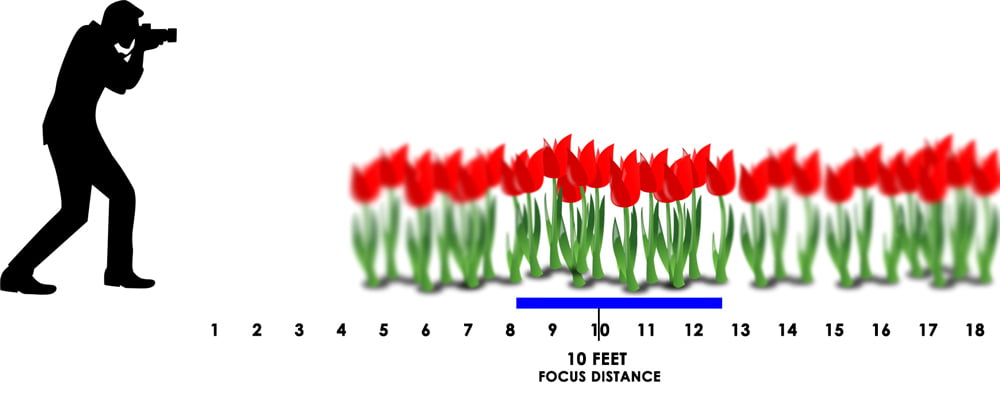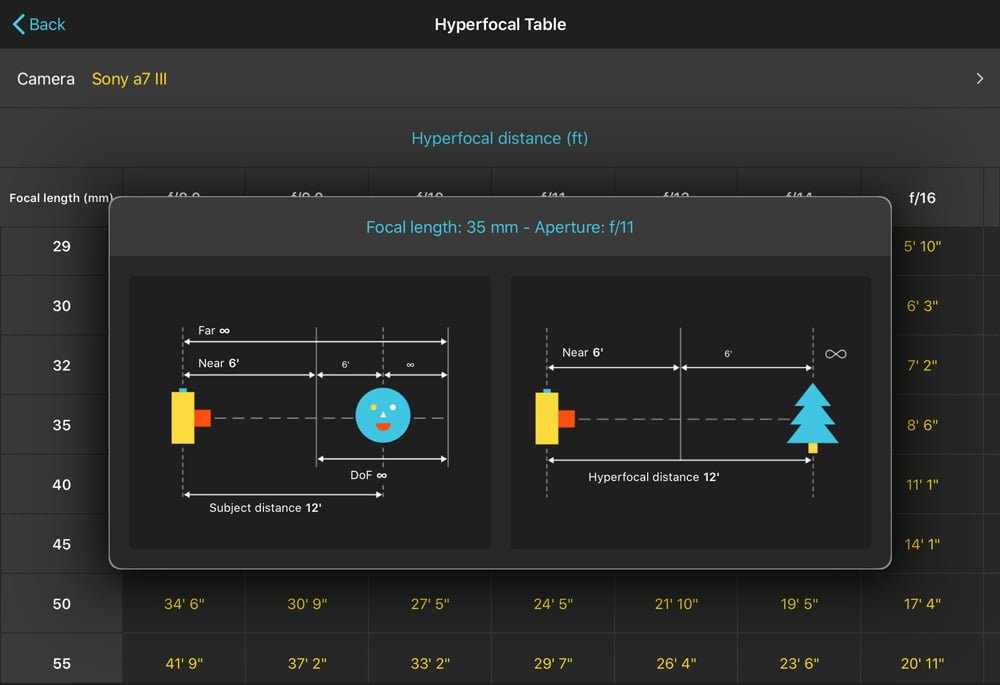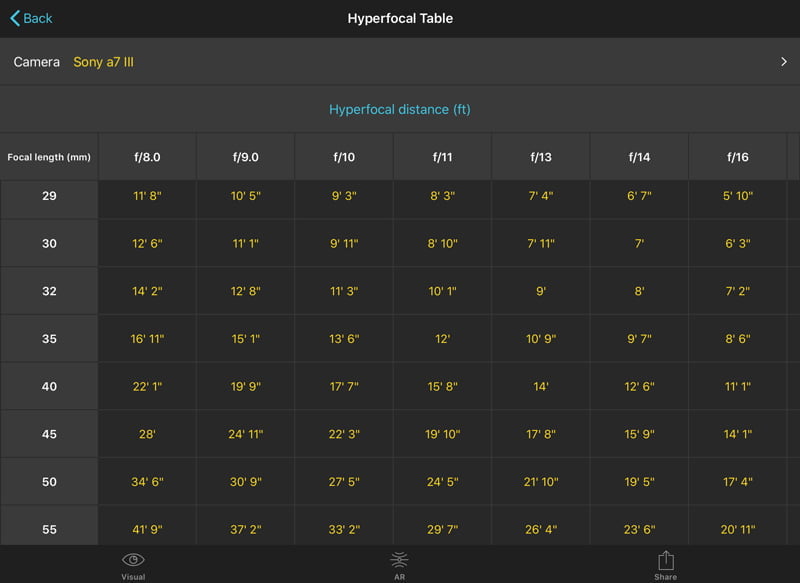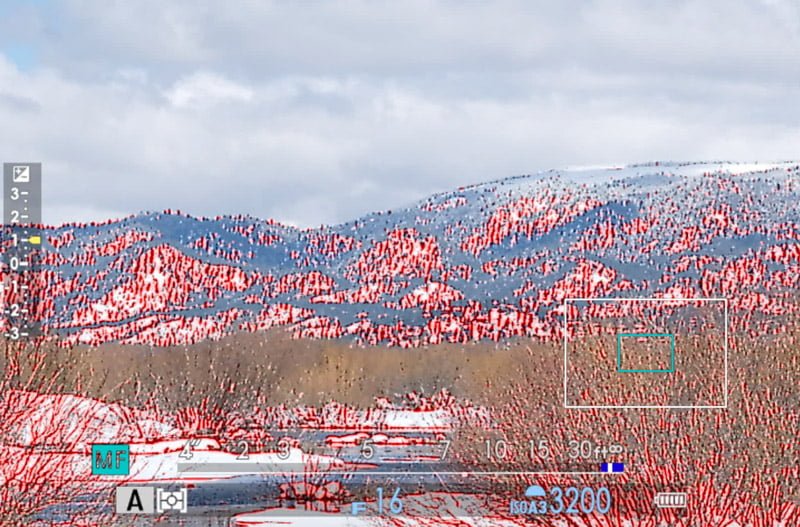Disclosure: This post may contain affiliate links. I earn a small commission of product sales to keep this website going.
If you really want to get the maximum sharpness out of your photos you should understand how to calculate hyperfocal distance. You can reference apps, calculators, and tables, but sometimes you just don’t have access or the time to look these up. This post will show you how to quickly get to hyperfocal distance with nothing but your camera.
What is Hyperfocal Distance?
Before we define hyperfocal distance, it’s important to first understand the definition of depth of field.
Depth of Field
The basic definition of depth of field is the distance from the closest object to the furthest object that appears reasonably sharp.
So if you’re photographing flowers and the closest flower in focus is 8 feet away from you (everything closer than that is blurry) and the furthest flower in focus is at 12.5 feet (everything beyond that is blurry), then your depth of field is 4.5 feet.

That’s a fairly shallow depth of field, in terms of landscape photography. A deeper depth of field would be something like 400 feet, or even infinity, where the far limit is beyond the horizon. Everything beyond that 8-foot near limit is in focus.
Your depth of field is going to vary be based on:
- Focal length
- Aperture
- Focus distance
You can read more about those relationships in this article.
Hyperfocal Distance and Depth of Field
When your lens is set at the hyperfocal distance, you’re going to get the deepest depth of field possible for that focal length and aperture. From a few feet in front of you and all the way to the horizon (infinity), it’s all gonna look sharp.
The book definition of hyperfocal distance is the closest a lens can be focused to make the horizon appear sharp. Thus, the deepest depth of field.
When you calculate hyperfocal distance and set your lens focus, everything from half your focus distance to infinity is going to appear in focus.
- If your hyperfocal distance is 20 feet, everything from 10 feet to infinity will appear to be in focus.
- If your hyperfocal distance is 40 feet, everything from 20 feet to infinity will appear to be in focus.

Why is Hyperfocal Distance Important?
Hyperfocal distance is important when you have layered photos – a foreground, mid-ground, and background – and you want them all in focus.
If you leave the camera in autofocus, or manual focus without using hyperfocal distance, you’re sacrificing potential depth of field. Let’s look at the following example to see what I mean.
The furthest flowers are at 20 feet. Your autofocus grabbed the furthest flower, focusing at a distance of 20 feet. The lens & aperture combination you’re using give you a depth of field of 9 feet. But the closest flower that’s in focus is at 17 feet. There’s 6 feet of “wasted sharpness” beyond the furthest flower.

If you focus at a distance of 15 feet, your depth of field shrinks from 9 feet to 8 feet, but now the closest flower in focus is at 12 feet instead of 17 feet. There is no “wasted sharpness” – you’re taking advantage of all of your potential depth of field.

Apply this to the concept of landscape & travel photography, when you want both the horizon in focus and everything close to you, and you can see why hyperfocal distance is important. No wasted depth of field!
Without hyperfocal distance, the grass in the foreground would have been blurry.

Finding Hyperfocal Distance
Everyone’s favorite method to calculate hyperfocal distance is looking up a table in an app like PhotoPills (iOS |Android). I love this app; it’s one of my favorite photography apps.

But pulling my phone out of my pocket, opening the app, going to the Hyperfocal Table, plugging in my camera, finding my focal length and aperture, then setting my lens to that focus distance…well, it’s often impractical.
If you’re a landscape photographer taking your time to set up a shot, you probably have time to do this. But still, actually setting your lens to that precise focus distance is a challenge unless you have a digital readout like on the Zeiss Batis lenses.

When you’re “on the go,” traveling, wandering the city or the countryside, there’s a better way to calculate hyperfocal distance.
How to Calculate Hyperfocal Distance WITH JUST YOUR CAMERA
We’re looking for the closest distance we can focus while making our horizon appear sharp, right? So why don’t we just manually focus near us, then adjust our focus until the horizon juuuust starts to come into focus?
Manually focus on the near flower and slowly adjust focus until the horizon appears sharp.



Key Points to Consider
You must set your aperture and compose your photo before finding hyperfocal distance. If you touch your lens zoom ring after starting this process, you’ll need to start over.
If you have a mirrorless camera, use your focus magnification tool. Do not zoom your lens, as discussed in the previous paragraph. Using your focus magnification tool will help you find where your horizon just comes into focus.

If you “stop down,” going from a larger aperture to a smaller aperture (smaller f-number to larger f-number), you do not need to recalculate hyperfocal distance. But if you open your aperture you will.
Sharper photos, not just for landscapes
Hyperfocal distance is a favorite concept for landscape photographers, but it’s not just for landscape photographers. I hope now you can see how this concept can apply to other types of photography when you want maximum depth of field.
Autofocus is great, but it’s not that great! Practice how to find hyperfocal distance using only your camera and you’ll get much sharper photos.

Martin Hyett
Friday 18th of September 2020
I have wondered whether camera manufacturers could put hyperfocal distance into the camera itself. They know the focal length and aperture set and they could have the hyperfocal distance tables stored for their own lenses. Then the photographer could ask the camera to set focus at the hyperfocal distance. Of course new lenses would mean a firmware update or an approximation calculated. Would it be possible, in theory?
Greg
Friday 7th of April 2023
@John Peltier In my case with mirrorless, what I see is what I get from f/5.6 and more open. If I set up a preview button to stop the lens down to, say, f/22, I cannot both stop it down and do a camera body scene magnification at the same time. If I just bring distant mountains into focus at f/22 but then decide to shoot at f/4, I lose the distant focus. So, would this technique only work at the previewed and chosen fstop?
John Peltier
Friday 18th of September 2020
In theory this should be totally easy. I'm no programmer but I did take a few computer science classes in college decades ago and even then this would have been easy. I've wondered the same thing, and also wondered why this hasn't been implemented anywhere yet. I'm sure there's some reason I haven't thought of yet...
Tom Gibson
Wednesday 13th of May 2020
I also see you have gone to Sony vs Fuji or are you just using Sony examples, table and lens, for this article. But screen shot of camera is Fuji.
John Peltier
Wednesday 13th of May 2020
This post is not specific to any make or model. The method will work for both DSLRs and mirrorless cameras. The screenshots are just screenshots.
Tom Gibson
Wednesday 13th of May 2020
In theory this might work for others, but I have problems using the highlight color(s) as I never know when all is in focus. I have read when the red or chosen color is the brightest all is in focus. I have problems doing this. I focus on the foreground point that I want in focus with a given F stop, F 8-11, with a cropped camera, Fuji vs FF, and check with the magnification to be sure all is in focus. If not I adjust, refocus on the foreground, and check the background to be sure it is in focus. If in doubt and I will want to print the image I use focus stacking and check my first and last frame to be sure it is in focus.
I wish I could use the highlight as it would be much easier and that is one reason I was excited about getting a mirrorless camera.....but I should have gone with a Sony FF for landscape vs the Fuji. I find the Fuji is great for on point focus when photographing people, event photography, or macro etc, but a challenge for landscspe and of course night photography.
John Peltier
Wednesday 13th of May 2020
This post is not about highlight peaking. I just used that as an example of what's possible. You don't need to use it; you don't even need to use focus magnification. Just do whatever works to make sure the horizon is sharp as long as you're not zooming a zoom lens to do it.